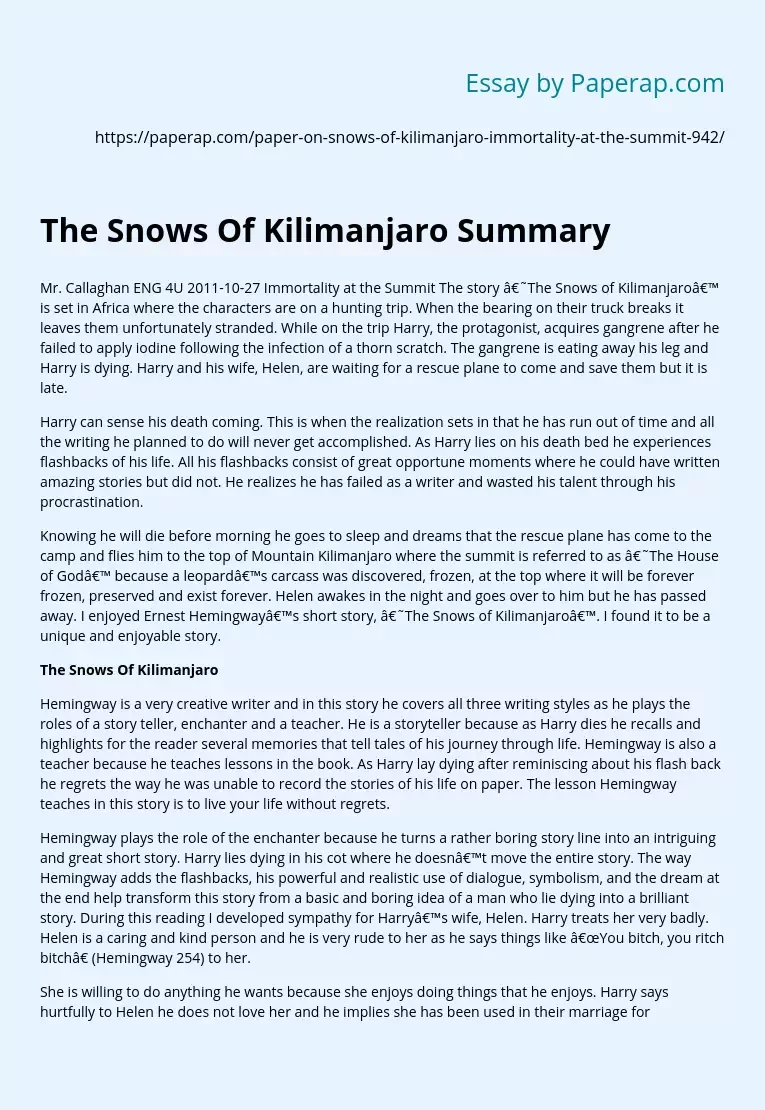The Snows Of Kilimanjaro Summary
Mr. Callaghan ENG 4U 2011-10-27 Immortality at the Summit The story ‘The Snows of Kilimanjaro’ is set in Africa where the characters are on a hunting trip. When the bearing on their truck breaks it leaves them unfortunately stranded. While on the trip Harry, the protagonist, acquires gangrene after he failed to apply iodine following the infection of a thorn scratch. The gangrene is eating away his leg and Harry is dying. Harry and his wife, Helen, are waiting for a rescue plane to come and save them but it is late.
Harry can sense his death coming. This is when the realization sets in that he has run out of time and all the writing he planned to do will never get accomplished. As Harry lies on his death bed he experiences flashbacks of his life. All his flashbacks consist of great opportune moments where he could have written amazing stories but did not. He realizes he has failed as a writer and wasted his talent through his procrastination.
Knowing he will die before morning he goes to sleep and dreams that the rescue plane has come to the camp and flies him to the top of Mountain Kilimanjaro where the summit is referred to as ‘The House of God’ because a leopard’s carcass was discovered, frozen, at the top where it will be forever frozen, preserved and exist forever. Helen awakes in the night and goes over to him but he has passed away. I enjoyed Ernest Hemingway’s short story, ‘The Snows of Kilimanjaro’.
I found it to be a unique and enjoyable story.
The Snows Of Kilimanjaro
Hemingway is a very creative writer and in this story he covers all three writing styles as he plays the roles of a story teller, enchanter and a teacher. He is a storyteller because as Harry dies he recalls and highlights for the reader several memories that tell tales of his journey through life. Hemingway is also a teacher because he teaches lessons in the book. As Harry lay dying after reminiscing about his flash back he regrets the way he was unable to record the stories of his life on paper. The lesson Hemingway teaches in this story is to live your life without regrets.
Hemingway plays the role of the enchanter because he turns a rather boring story line into an intriguing and great short story. Harry lies dying in his cot where he doesn’t move the entire story. The way Hemingway adds the flashbacks, his powerful and realistic use of dialogue, symbolism, and the dream at the end help transform this story from a basic and boring idea of a man who lie dying into a brilliant story. During this reading I developed sympathy for Harry’s wife, Helen. Harry treats her very badly. Helen is a caring and kind person and he is very rude to her as he says things like “You bitch, you ritch bitch” (Hemingway 254) to her.
She is willing to do anything he wants because she enjoys doing things that he enjoys. Harry says hurtfully to Helen he does not love her and he implies she has been used in their marriage for her wealth when Harry says “Your damned money was my armour” (Hemingway 253). It bothers me that Harry could be so rude and disrespectful to his wife when she has been so caring and loving towards him. Helen deserved a much better husband than Harry. Another thing I liked from Hemingway’s story is his interesting use of symbolism through animals. In the story he uses the location of the vultures to correlate Harry’s physical well being.
Vultures started circling in the sky and as Harry weakens they moved to the ground. When death creeps even closer more vultures came. Hemingway uses a special writing style for Harry’s flashbacks. He replaces several commas with “ands” with the aim of creating run on sentences. This style makes the reader feel as if they can visualize Harry’s memories flashing quickly before their own eyes. “The Snows of Kilimanjaro” is an appealing story. It is well written and draws the reader in. Hemingway’s writing style is sure to attract and please many readers. Exploring some of Hemingway’s other works would certainly be worthwhile.
The Snows Of Kilimanjaro Summary. (2019, Dec 05). Retrieved from https://paperap.com/paper-on-snows-of-kilimanjaro-immortality-at-the-summit-942/

